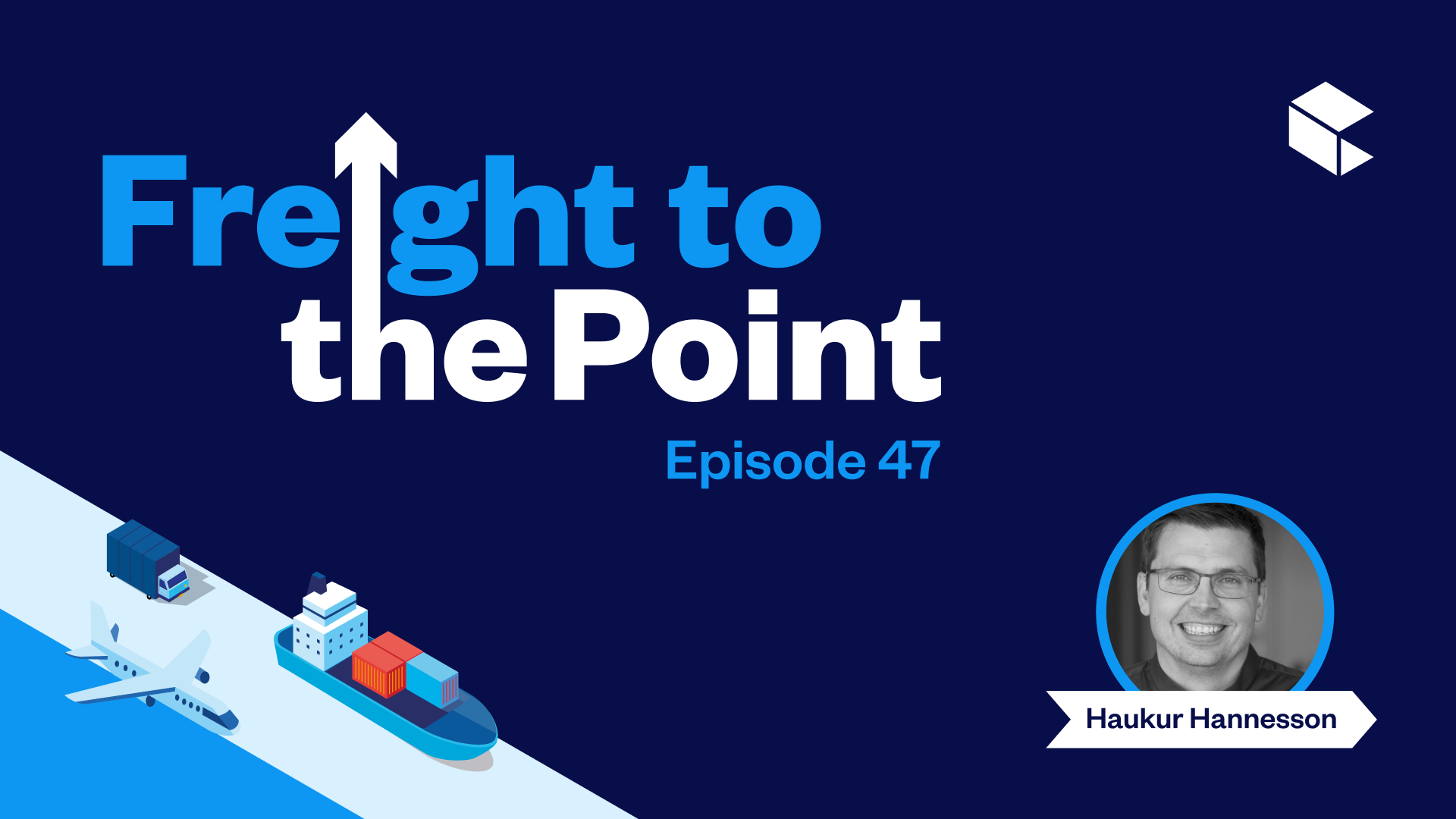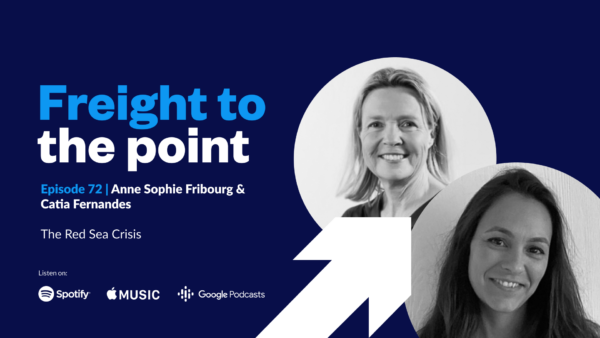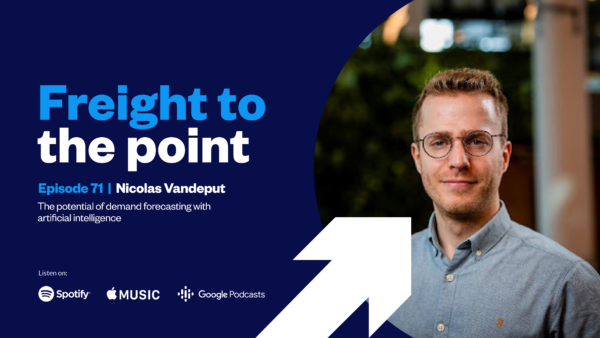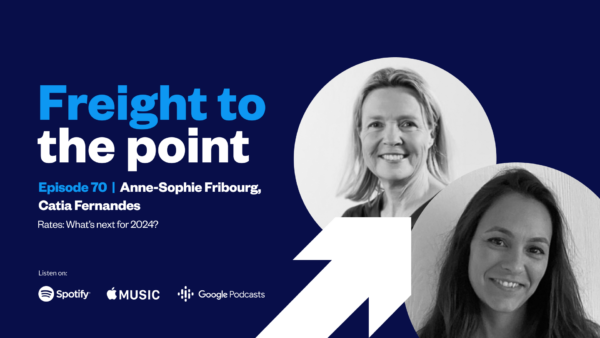Episode 47:
How should businesses approach inventory management?
See all episodes

We’ve spoken a lot about consumer demand and when businesses should be restocking.
But the big question is: How should businesses manage their inventory to remain agile?
This is what we explore with Haukur Hannesson, CEO at AGR Dynamics as he joins Alex Hersham to talk about the value of inventory management and importance of demand and supply data.
They talk about:
- How the relationship between inventory management and supply chains have evolved
- The importance of having access to the right data
- How businesses should be approaching inventory management in the supply chain.
Haukur Hannesson
Haukur Hannesson is the CEO of AGR Dynamics and has been working for more than 20 years with the AGR customer base to minimise waste in their supply chain. Before becoming the CEO of AGR in 2008, Haukur was working as a supply chain consultant at AGR.
Resources
Alex Hersham:
Hi, everyone and welcome to another episode of Freight to the Point, a podcast by Zencargo. I’m Alex Hersham, and today I am joined by Haukur Hannesson, who is the CEO of AGR Dynamics. AGR, a partner who we work quite closely with to help drive supply chain optimization for our customers. Through accurate demand planning, forecasting, and inventory optimization, AGR enables businesses to improve revenue, reduce cost by preventing stockouts and decrease excess inventory, all key things in most economic environments, definitely in today’s economic climate. Today, Haukur and I will be talking about inventory management during the destocking period and beyond. Welcome, thank you so much for taking the time to join us today.
Haukur Hannesson:
Yes, thank you so much. I’m excited to participate.
Alex Hersham:
Great. So let’s dive right into it. Why is everyone talking about inventory right now?
Haukur Hannesson:
The reason for that is that all the supply chain, there is so much transformations ongoing within the supply chain. It started with COVID where the demand part of the supply chain was heavily impacted, both due to many of our customers who were working in many countries, they were maybe closing their stores in one country, opening it up again than in another country. They were closing at that different time, restriction on how many customers could come into the stores and things like that. Then COVID is behind us. And then we have the supply chain crisis where we are having manufacturing companies all around the world having difficulty on the supply side. So when you’re planning for your inventory, you’re not only looking at the demand part, you’re looking at the supply side and we are focusing on the demand side. But we have our customers looking more and more into it to get an insight into what is happening on the supply side. And then what is coming in now and why everyone is talking up about it now it’s the inflation.
So we have an inflation. So costs are rising and it’s having different impact on different product groups and wholesalers need to raise the prices that goes into the retail and that impacts the demand. And because if the product is too expensive for you, you stop buying it and if you stop buying it, it’s heavily important for the supply chain controlling the stock to keep the right stock levels. Because otherwise, they are just heavily overstocked with items that are costing them more today than it was costing yesterday. So all those together is probably the reason why everyone is finally speaking about those things.
Alex Hersham:
Yeah, it’s definitely been a rollercoaster of two years, but what I find interesting in supply chains in general is that the last couple of years have just accelerated a trend that was already there and we see that a lot in Zencargo about more agile supply chain management. Maybe you can share a little bit about how the role of inventory has changed over the last two decades and that probably will speak to some of these trend accelerators that we saw.
Haukur Hannesson:
What has cost those changes is, of course, the changes on the demand side. It means that the companies that are selling their products, the changes in the ranges is changing much faster than before. So instead of changing your range, maybe the product stays there for 5 years, 10 years. It’s only staying for few years or few months even. And if you have the product only staying in your range for a few months, it’s a key to have the supply chain as a whole agile because otherwise, you’re just stuck with all that stock in the supply chain. Some of it is in the store, but it’s also on the way from the manufacturing company to the warehouse and from the warehouse to the store. And if you’re just having way too much stock in the supply chain, you’re not able to adapt quickly enough based on the need of the market where you have consumers that would like to see new products in the stores, see new ranges. And that is what is driving the demand, is the change of the product range within the store.
Alex Hersham:
One of the reasons why we saw in Zencargo sort of six or seven years ago was we saw these emerging trends coming from retail e-com, omnichannel industries and felt that they were going to need much more agile supply chains. And I guess, within that, something that we’ve seen a lot of is this sort of connectivity between the supply chain team and the merchandising or buying team. So it’s bridging these two things. What are you seeing then? How is the relationship between supply chain and inventory management evolved?
Haukur Hannesson:
And this is probably the other change. When we started AGR in the beginning of the century, the companies just simply didn’t have data that was good enough to use in the decision making. So first, it was to make sure they have the data within their systems, within their ERP systems that they have accurate stock data. Then it was to have the systems where available to use that data, to use the algorithms, to have the decision making based on the data they have. Then what is coming more now into play, it’s not only to use your own data to take better decisions for yourselves, it’s to share that data through the supply chain. So it’s not only the good stuff traveling through the supply chain and the invoices or the money that is traveling back, it’s also the information throughout the supply chain to various points within the supply chain to prevent the pullback effect that can heavily impact the supply chain if you don’t share the information.
And what we are seeing with the customers themselves which are in our case retailers and wholesalers where they are coming with their data and pushing it to the distributors or the manufacturers and asking them to use their data. It’s also coming from the other end where the distributors are requesting those wholesalers or retailers to give them data so they can plan their side of the supply chain in a much better way. It started with, like I said, to be able to use your own data, but now it’s about sharing that data between various parties within the supply chain. And this is probably one of the reason for the partnership between Zencargo and AGR from our side is that in the past, we were mainly or only looking at the demand side and then what is heavily impacting their decisions is what is happening on the supply side.
And we need data from there, which is not within our system and not something that we are doing. But we still need access to that data somehow to allow our merchandiser or buyers to take the decisions about how much to order, when to order the stock. And this is coming much more into play now. And for example, I remember one recent example of a wholesaler of ours in ordering a lot of stock from the warehouse, from their partner in China. And then during the COVID period, they closed their operation and they needed to go into different suppliers with lesser lead time and they started to buy from them. And then suddenly, a year later, the stock arrived from China and they were heavily overstocked. So they need the overview of what is happening everywhere in this supply chain, not only on the team side but also on the supply side where you need to use the data there and share it between the parties there.
Alex Hersham:
Yeah, that’s so interesting. I mean, that real life example of the buyers or the merchandisers just needing the data of what’s happening when it comes to inventory flows to help them think about what they need to order, help them think about where they need to work with the supply chain team to maybe accelerate some inventory or even reroute inventory. Again, that’s so core to why Zencargo has started and the power that we think can be unlocked and unleashed through the supply chain. But I really love that insight there as well about not just better internal collaboration because five years ago or even three years ago, it was very difficult to do some internal collaboration because you didn’t have this inventory visibility. But I love that point about sort of multi-stage supply chain collaboration and sharing it with the manufacturers and allowing them to think about their supply chain, their ordering cycles earlier and to have more collaboration and dynamism and as a result probably strength and resilience through the supply chain.
That’s super interesting and not a trend that I’d thought about much, so thanks for sharing. So building on this, the role of the supply chain team in the past has been, keep costs down and make sure inventory flows. If I had to create a mission statement, that’s what I would sort of say the mission statement of the 2000s was, or even sort of the first part of the 2010s were in terms of the mission statement for the supply chain function. Obviously, that has completely changed and most people have realised that has changed. And so, we’re seeing a real change in how supply chains want to operate, how they want to collaborate, how they want to create visibility. But from your perspective, beyond simply guaranteeing supply, how should supply chain support this broader content of average management?
Haukur Hannesson:
So one is about the financial part like, you’re coming not to be overstocked and the huge financial impact that is on those companies. It’s also about having the available stock like you mentioned. But what I’m seeing coming more into play now is also to use the time of the people that are controlling the supply chain more effectively, not have a waste of their time. They should be using the data and systems to take decisions for them and then also highlight where you want to have a person that knows the supply chain to come to the system and where you want to have a person to take some of the decisions. And then what I’m seeing more and more coming into play it’s the environmental aspect of it because if you’re not controlling your supply chain in the right way, it’s having a huge impact on the environmental part.
And that can be for many reasons. For example, we see that some of our customers due to not controlling the stock in the right way, so they don’t realise they’re having issues with stockouts and they don’t realise the stock is out until it’s just screaming at them in the shelf or a customer is screaming at them. And instead of getting the stock transported with ship, they’re taking it with airplanes, which is having much more impact on the environment, the transportation method that you use to deliver the stock to the warehouse. And then the second part is that if you’re having the wrong stock in the warehouse or in the store, it’s the waste goes through the roof. And, of course, it’s obvious for the companies and the companies with past before date in food and things like that, they have focusing on that for years.
But it’s also due to the fact that we were discussing here in the beginning, if the product rates are constantly changing and you’re overstocked or even not having the stock yet because you don’t have the overview what is happening in the supply chain, you need to throw away your stock. And that is having a huge impact on the environmental part. And I’m seeing some companies starting to focus more on the supply chain just due to pressure from their shareholders or from the ports to do something about that part. And this goes hand in hand if you are focusing on the financial part. We at AGR, we say that we are focusing on minimising waste in the software chain and it’s both waste in terms of the environment, but it’s also the financial waste and the waste of time for the users that are using our system for the decision making on when to order and how much to order and what is coming more into play, which is usually done outside of our system. How to expedite the orders if you need it before than was expected.
Alex Hersham:
And that’s where we come in, whether it’s expediting an order or the reverse actually slowing down an order which can be more environmentally efficient and consolidating it or re-routing a purchase order. You ordered a 100 T-shirts from the UK actually, that inventory would be better used in the US. And this is where I love how AGR and Zencargo can work on the partnership side because your sort of analogy there. Let’s reduce waste across waste and spend, waste in time, waste in environmental emissions, which all ties back to the right inventory at the right price, at the right location is key. And I think that comes down to better demand planning, better demand forecasting, better understanding of what’s happened in the past when you’ve raised orders in the lead times and then more agile inventory management. And when you connect those things together, I really think special things happen. And again, it seems like we started our business with a sort of similar raison d’etre.
Haukur Hannesson:
And you’re able to do that now because you’re doing it. The data you have is on such a granular level, you are doing the demand or the forecasting part on the lowest level. You are trying to figure out what each store for each item, what is the need for that in coming days, weeks, and months. And then you’re aggregating that up to the level where you can have impact on the supply chain, which is outside of our system. And we’re seeing this coming much more into play now that our users, they need not only to take those decisions on the demand side, they also need to take their decisions on the supply side. And those two sides, they need to interact with each other. So it’s both for when you’re taking decisions to expedite orders, you need to know the demand, you need to know the expected demand in coming days, weeks and months.
Alex Hersham:
Oh, yeah. The amount of times that in supply chain we hear things like, “The merch team asked us if we could speed up the ship” or the merch team asked us, “Hey, can you expedite this order by air freight?” And then it sat in a warehouse for weeks. And my hope is that through the work that you do and through the work that we do and through the sort of broader education, both supply chain roles and buying in roles are actually really very difficult that you can constanstly are thrown from pillar to post that by the work that we do, we can bring those teams again, to use your phrase, reduce waste and drive better business and better societal outcomes. But let’s talk in the last couple of minutes around AGR specifically and around this sort of concept of modern inventory management. So what AGR dynamics do reflect your vision for how businesses should be approaching inventory management and everything that you’ve shared on this call so far?
Haukur Hannesson:
Yeah, the vision that we have is to use the data effectively, all the data. You have both internal data and external data and have advanced algorithms methods to use that data to take better decisions for you on what is the expected demand, when to order, and how much to order its time. And what drives me is to use that unused source to minimise waste in the supply chain. And the impact that we can have is, it’s a drama. The impact we can have, it’s a huge impact we can have on the life of wholesalers and retailers because of the financial impact. But what drives me is the environmental impact that we can have, much more impact than we can have anywhere else as an individual and as a company. Because the success of our customers is the success for the environment, if they control the supply chain in the right way.
Alex Hersham:
That leveraged impact through the supply chain is very powerful. Maybe you can speak a little bit then about some specifics. You’ve talked about the vision, you’ve talked about how you think inventory management should be done, collaboration, internal, external. Maybe you can share a couple of examples of how you actually work with your customers to optimise imagery levels and reduce waste across all the pillars that you mentioned.
Haukur Hannesson:
So the companies that we are dealing with is all from relatively small wholesalers up to retailers in multiple countries with 100s of stores. Usually when we join them, they usually have either a very customised functionality done in the ERP system. Or most of them have some homemade Excel sheets to trying to figure out what the demand is and when to order and how much to order. And what the implementation drives through, it’s not only sometimes we have seen the success come through before the implementation is over. So they have not even starting to use our system, but we are already seeing results in lowering inventory in better service levels for those companies. Because it’s both about the individuals are starting to think more up into those directions, but it’s also discipline we put in play that you split your orders into daily, weekly, monthly routines.
And then you get the impact when you, you’re not only calculating what you’re most likely to sell in coming days, weeks, and months, it’s also how predictable is the demand, how sure can you be that the demand will be x. And we calculate that by seeing what is the unpredicted variance in sale? And if you have high variance in sales, we bring in safety stock, we calculate how much safety stock for each item in every store, which is based on this, how predictable the item is and then how important the item is. And we also assist the customers to figure out what are the most important items for them.
And that is both for the calculation of the safety stock, but also, it’s about making sure that they have their focus on the items that are the most important. Which is actually just a method that has been used for decades, which is just an ABC Pareto analysis, which is either done on machine or on sale. And even though this method has been known for decades, most of our customers have not been using it effectively before they start using the system even though they know this method before they come.
Alex Hersham:
Well, I don’t envy anyone that has to do demand forecasting. One thing that I always tell anyone that will listen is when you have thousands or tens of thousands of skews across different geographies, and when you sort of treat that as regional inventory rather than fulfill from anywhere inventory, life is already extremely hard to predict many months out, especially when you then have long supply chains. So you’re not predicting next month, but you’re predicting next quarter or two or three quarters out. It’s very difficult. But it definitely seems like what you are doing at AGR is really driving impact. And again, just to borrow your term, reducing waste across spend, across time, and most importantly, to you across environmental and ESG requirements, which is fantastic. And I’m super excited about the stuff that we’re going to be doing together and have already done together with clients to try and bridge that gap between great demand forecasting, great understanding of what supply chains really look like, and then creating more agility within the supply chain. And when you bridge those two worlds, I think it’s super powerful.
So listen, thank you so much for making the time. I’m delighted about our partnership and the work that we’re doing together and hopefully we can do one of these sessions again in a few months time and speak specifically about some of the customers that we’re driving outcomes for. I think that’d be a great session. So thank you very much. And thank you very much to everyone for joining us for another episode of Freight to the Point. I’ve really enjoyed this, I hope you have too, don’t forget to like and subscribe across Spotify, Apple Podcasts or Google Podcasts. And if you have any questions, please either reach out to me or the team and we’ll be happy to answer them on LinkedIn or via email. Thank you very much, everyone. Take care.

Episode 72: The Red Sea Crisis
In the latest episode of Freight to the Point, we’ve featured our most rec...

Episode 71: The potential of demand forecasting with artificial intelligence
In the most recent instalment of Freight to the Point, Lucie Phillips, Zen...

Episode 70: Rates: What's next for 2024?
As we prepare for the year ahead, it's crucial to consider the three pillars...

